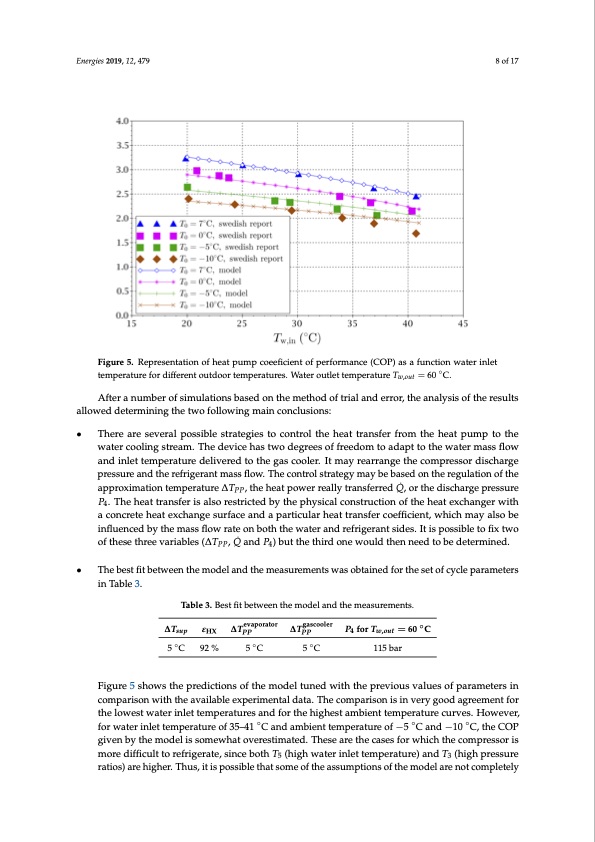
PDF Publication Title:
Text from PDF Page: 008
Energies 2019, 12, 479 8 of 17 Figure 5. Representation of heat pump coeeficient of performance (COP) as a function water inlet temperature for different outdoor temperatures. Water outlet temperature Tw,out = 60 ◦C. After a number of simulations based on the method of trial and error, the analysis of the results allowed determining the two following main conclusions: • There are several possible strategies to control the heat transfer from the heat pump to the water cooling stream. The device has two degrees of freedom to adapt to the water mass flow and inlet temperature delivered to the gas cooler. It may rearrange the compressor discharge pressure and the refrigerant mass flow. The control strategy may be based on the regulation of the approximation temperature ∆TPP, the heat power really transferred Q ̇ , or the discharge pressure P4. The heat transfer is also restricted by the physical construction of the heat exchanger with a concrete heat exchange surface and a particular heat transfer coefficient, which may also be influenced by the mass flow rate on both the water and refrigerant sides. It is possible to fix two of these three variables (∆TPP, Q ̇ and P4) but the third one would then need to be determined. • The best fit between the model and the measurements was obtained for the set of cycle parameters in Table 3. Table 3. Best fit between the model and the measurements. ∆Tsup εHX ∆Tevaporator PP 5 ◦C 92 % 5 ◦C ∆Tgascooler P4 for Tw,out = 60 ◦C PP 5 ◦C 115 bar Figure 5 shows the predictions of the model tuned with the previous values of parameters in comparison with the available experimental data. The comparison is in very good agreement for the lowest water inlet temperatures and for the highest ambient temperature curves. However, for water inlet temperature of 35–41 ◦C and ambient temperature of −5 ◦C and −10 ◦C, the COP given by the model is somewhat overestimated. These are the cases for which the compressor is more difficult to refrigerate, since both T5 (high water inlet temperature) and T3 (high pressure ratios) are higher. Thus, it is possible that some of the assumptions of the model are not completelyPDF Image | Comparison of Transcritical CO2 and Conventional Refrigerant Heat Pump

PDF Search Title:
Comparison of Transcritical CO2 and Conventional Refrigerant Heat PumpOriginal File Name Searched:
energies-12-00479.pdfDIY PDF Search: Google It | Yahoo | Bing
CO2 Organic Rankine Cycle Experimenter Platform The supercritical CO2 phase change system is both a heat pump and organic rankine cycle which can be used for those purposes and as a supercritical extractor for advanced subcritical and supercritical extraction technology. Uses include producing nanoparticles, precious metal CO2 extraction, lithium battery recycling, and other applications... More Info
Heat Pumps CO2 ORC Heat Pump System Platform More Info
| CONTACT TEL: 608-238-6001 Email: greg@infinityturbine.com | RSS | AMP |